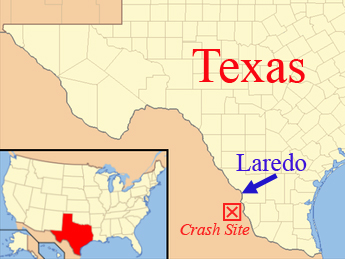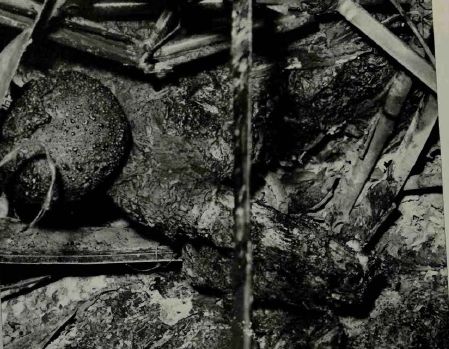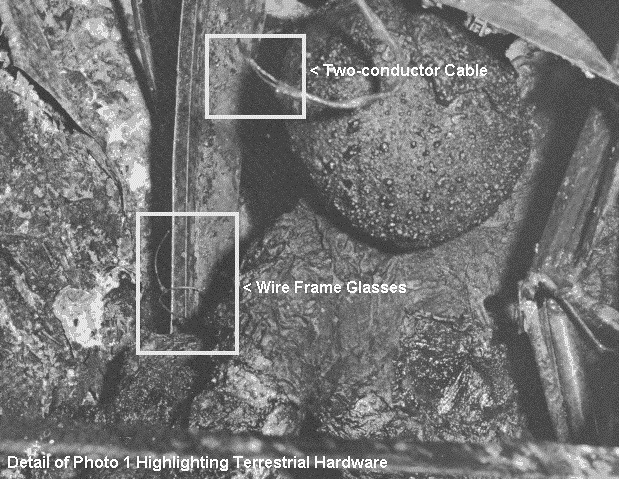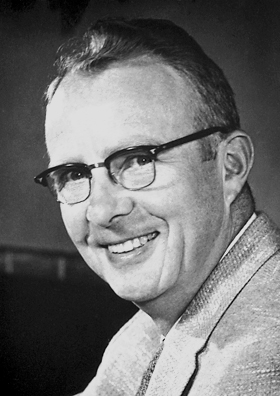The
Laredo, Texas UFO crash is a case in which at least two
U.S. military aircraft allegedly chased a 90-foot-diameter
(27 m) silver disc-shaped unidentified flying object (UFO)
across Texas before watching the object crash approximately
30 miles (48 km) south-southwest of Laredo, Texas on July
7, 1948. U.S. servicemen were reportedly dispatched from
a nearby military base to cordon off the UFO crash site
until a special U.S. retrieval team arrived to examine
the wreckage and carry it away to a military base in San
Antonio, Texas. Supposedly, the badly burned body of a
non-human entity was recovered from the crash site.
Texas
Monthly magazine recently included the Laredo UFO Crash
on a list of the eight most significant UFO cases in Texas
history. This case is said to have occurred almost exactly
one year after the more famous Roswell UFO Incident. Rumors
about this case first began circulating in the 1950s,
although details were not widely known until 1977. This
case shares similarities with the Del Rio, Texas UFO Crash
of 1955 and the Coyame UFO Incident of 1974, both of which
reportedly also occurred along the Texas-Mexico border.

Map Showing Location of Alleged 1948 UFO Crash.
Original
source of report
According
to Texas Monthly, talk of a UFO crash near Laredo first
surfaced in the 1950s, with additional details being released
in 1978 by the late Leonard Stringfield, one of the first
UFO researchers to advocate serious investigation of reported
UFO crashes. Stringfield wrote, "In the Fall of
1977, new word of a 1948 crash came to me from a well-informed
military source. His information, however, was scanty.
He had heard from other "insider" military sources
that a metallic disc had crashed somewhere in a desert
region. His only details indicated that the craft had
suffered severe damage on impact and was retrieved by
military units."
Also
in 1977, Stringfield received more information about the
case from another UFO researcher, the late Todd Zechel.
Stringfield wrote, "Formerly with the National Security
Agency, Zechel stated that a United States Air Force technician
told him that his uncle, then a Provost Marshall at Carswell
Air Force Base near Fort Worth, Texas, had taken part
in the 1948 recovery of a crashed UFO, which was described
as a metallic disc, 90 feet in diameter."
In
a report presented at the Mutual UFO Network (MUFON) Symposium
on July 29, 1978, Stringfield stated that "one dead
alien was found aboard the craft, which was described
as about 4 feet, 6 inches tall, completely hairless, with
hands that had no thumbs."
In
December 1978, two photographs fitting Stringfield's description
of the dead alien suddenly appeared in Maryland. The photos,
along with a brief note about them, were received in the
mail by Willard F. McIntyre, founder of a civilian UFO
group called the Mutual Anomaly Research Center and Evaluation
Network (MARCEN). The photos showed the badly burned body
of a small biped with a large head and clawlike hands.
The photos were purportedly sent by a retired U.S. Navy
photographer from Tennessee who claimed to have taken
them at a UFO crash site along the Texas-Mexico border
in 1948.
McIntyre
corresponded by mail with the unnamed former Navy photographer
from 1978 through 1981 and learned more details about
the Laredo crash, which McIntyre later disclosed to numerous
civilian UFO organizations.[4] McIntyre claimed that MARCEN
had thoroughly checked out the photographer's military
service record and had verified that he was who he claimed
to be. McIntyre further claimed that the Eastman Kodak
company and the UFO group Ground Saucer Watch (GSW) had
both independently verified that the negatives of the
photos given to McIntyre in 1978 were approximately 30
years old.
The
photos were first released to the media in April 1980
by Charles Wilhelm, director of the now-defunct Ohio UFO
Investigators League (OUFOIL), were picked up by the Associated
Press, and were published in a number of U.S. newspapers,
including the Cincinnati Enquirer (on April 29, 1980).
Initial
sighting
Based
on a number of accounts published in the late 1970s and
early 1980s, a large UFO was spotted in the airspace above
Albuquerque, New Mexico on the afternoon of July 7, 1948,
moving at approximately 2,000 miles per hour. Stringfield
said that the object "was tracked on radar screens",
and other sources stated that the object at one point
made a 90-degree turn before heading toward southwest
Texas.
It
is important to note that in the 1980s, some UFO researchers
confused this story with that of the Del Rio, Texas UFO
Crash of 1955, which also occurred along the Texas-Mexico
border. Some of the early accounts of the Laredo crash,
therefore, contain inaccuracies based on this confusion.
Jet
intercept
A
number of UFO investigators have stated that, prior to
crashing near Laredo, the UFO was chased across the skies
of Texas by at least two military aircraft. Neither the
type of aircraft nor the base from which they were dispatched
is known. Schaffner referred to the aircraft as Lockheed
F-94 Starfire jets; however, the F-94 was not in use until
1949. It is possible that the actual aircraft involved
were Lockheed P-80 Shooting Star jets, of which the F-94
was a variant.
It
is also not known if the pursuing aircraft might have
contributed to the downing of the UFO by firing upon it
or otherwise causing it to fall. However, there are numerous
other documented cases of U.S. military aircraft firing
upon UFOs during this time period.
UFO
crash
Stringfield
wrote that the UFO crashed "about 30 miles inside
the Mexican border across from Laredo, Texas, and was
recovered by U.S. troops after it was tracked on radar
screens." Ohio UFO investigator Ron Schaffner
wrote, "At 1410 hours, other pilots in pursuit
said the object was slowing down and was wobbling in flight.
By 1429 hours, the object disappeared from all radar screens.
Using triangulation from all the radar installations,
it was determined that the object must have gone [sic]
down in Mexico, approximately 30 miles south of Laredo,
Texas."
The
location of the crash was given more specifically in UFO
Crash at Aztec: A Well-Kept Secret, a 1986 book by William
S. Steinman and Wendelle C. Stevens. They wrote, "This
site was about 30 miles SSW of Laredo, not far from the
highway to Mexico City, and near where the Rio Sabinas
joins the Rio Salado before they empty into the Rio Grande,
in the Sierra Madre Oriental."
The
crashed UFO was described by Steinman and Stevens as follows:
"As best the source could ascertain, the craft
was nearly perfectly circular and was about 90 feet in
diameter and about 28 feet [8.5 m] in thickness at the
center and tapering off to about 5 feet [1.5 m] thick
at the perimeter. There appeared to be five or six levels
in the center of the craft and they were told some sort
of instrumentation and machinery were removed before they
had arrived. No propulsion system or mechanism was apparent
to the source."
Securing
the crash site
According
to Stringfield's account of the Laredo case, a provost
marshal stationed at Carswell Air Force Base near Fort
Worth admitted that he had taken part in a mission to
cordon off and secure the site where a UFO crashed to
the Earth near Laredo, Texas in 1948. The marshal told
his nephew, who later told UFO researcher Todd Zechel.
Stringfield later wrote, "Zechel learned from
his sources that the troops involved in the retrieval
were warned that if they said a word about the incident,
they would be the sorriest people around."
Steinman
and Stevens later identified the eyewitness as John W.
Bowen, who they said "was sent over to take immediate
charge of cordoning off and controlling the area."
According to the authors, after Bowen's group secured
the area, a team was flown in from the missile range at
White Sands, New Mexico to photograph the crash site,
and later, a convoy of large Army transport trucks removed
the wreckage, taking it the San Antonio Air Depot for
further study.
Burned
body
Early
in 1978, Stringfield described the humanoid found at the
crash site as "about 4 feet, 6 inches tall, completely
hairless, with hands that had no thumbs." That
description seemed to fit the body shown in two photographs
that were mailed to MARCEN founder Willard F. McIntyre
on December 1978. Shaeffner later described the body shown
in the photos: "There was one body found within
the craft. The photographers managed to get a series of
pictures even though there was intense heat. When the
object cooled down, the body was removed to a hill side
and another series of pictures were taken. The body was
said to be 4 feet 6 inches [1.4 m] long with a head extremely
large compared to the torso."
In
1986, Steinman and Stevens added, "They [the military
photographers] only saw and photographed one body but
rumors were floating around the site that two or more
creatures had been blown out of the vehicle and were captured
and taken away injured severely but still alive. Our source
said he had no confirmation of this aspect of the case.
The body they photographed was 4' 6" long. Its head
was extremely large for the body size by human proportions.
The eyes were gone from the fire but the eye sockets were
much larger than in humans and were almost wraparound
as if to give 180-degree vision. There were no visible
ears or nose, but there were openings where ears and nostrils
would have been in humans. There were no lips and the
mouth was just a sort of slit with no teeth or tongue.
There were two legs of normal proportions with short feet
having no discernible toes. The two arms were longer than
in humans and the hands had four claw-like fingers each
with no apparent thumbs. The arms and legs appeared to
have joints in approximately the same places as in humans."
Shaeffner
wrote, "Army doctors arrived on July 8 and performed
an examination of the body. They could not find any reproductive
organs. They compared the gray skin to the texture of
a human female breast. The bone structure was more complicated
than a human and no muscle fiber was discovered within
the torso."


"Tomato
Man"
The
body depicted in the photos sent to McIntyre has over
the years come to be known as the "Tomato Man"
due to its large, roundish head. Many UFO researchers,
including Shaeffner and Kevin Randle, believe the body
is that of a human pilot who was badly disfigured by intense
heat following a plane crash. They argue that one of the
photos shows a pair of eyeglasses, such as a human pilot
would wear, near the body. Randle has classified the entire
"Tomato Man" story as a "hoax."
Other
researchers believe the body might be that of a monkey
used as a test subject in a missile experiment. Still
other UFO researchers argue that even if the "Tomato
Man" photos are fakes, that does not necessarily
invalidate the UFO crash incident itself, knowledge of
which preceded the appearance of the photos.
Aftermath
Steinman
and Stevens looked into a rumor that notable U.S. scientist
Luis W. Alvarez, now deceased, may have been involved
in an investigation of the site where the Laredo UFO Crash
occurred. Supposedly in July 1948, Alvarez and other top
U.S. scientists were taken under circumstances of complete
secrecy to a location in the Sierra Madre Oriental mountains
of Nuevo Leon, Mexico, which is the general vicinity of
the alleged Laredo UFO Crash. Their mission was to "examine
the residue on site of a crashed 100-foot-diameter [30
m] circular flying vehicle of unknown origin."
As a scientist, Alvarez was noted for applying scientific
principles to paranormal subjects. Steinman and Stevens
contacted Dr. Alvarez in the late 1980s and asked whether
he was involved in any investigations of crashed UFOs,
but he refused to make any comment to them.

Physicist
Luis W. Alvarez.
Source:
http://en.wikipedia.org/wiki/Laredo,_Texas_UFO_crash
